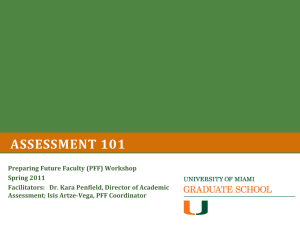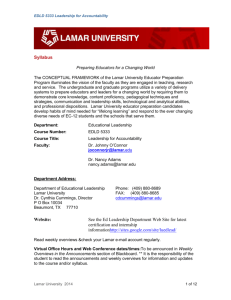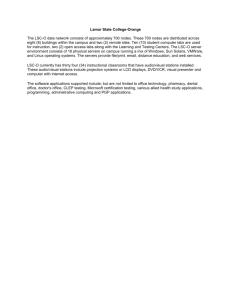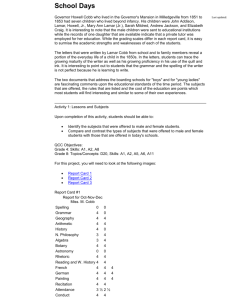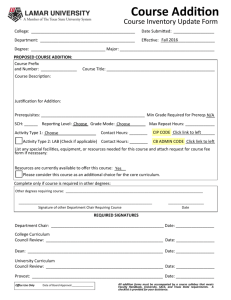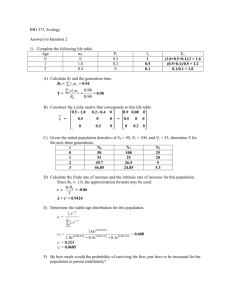File
advertisement
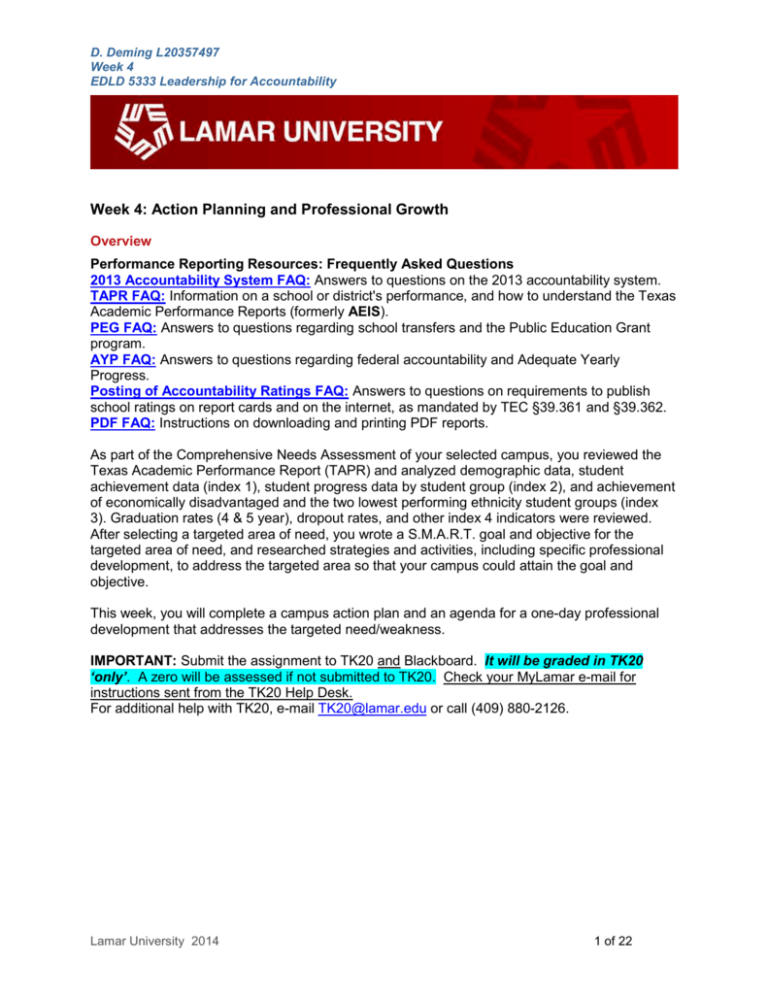
D. Deming L20357497 Week 4 EDLD 5333 Leadership for Accountability Week 4: Action Planning and Professional Growth Overview Performance Reporting Resources: Frequently Asked Questions 2013 Accountability System FAQ: Answers to questions on the 2013 accountability system. TAPR FAQ: Information on a school or district's performance, and how to understand the Texas Academic Performance Reports (formerly AEIS). PEG FAQ: Answers to questions regarding school transfers and the Public Education Grant program. AYP FAQ: Answers to questions regarding federal accountability and Adequate Yearly Progress. Posting of Accountability Ratings FAQ: Answers to questions on requirements to publish school ratings on report cards and on the internet, as mandated by TEC §39.361 and §39.362. PDF FAQ: Instructions on downloading and printing PDF reports. As part of the Comprehensive Needs Assessment of your selected campus, you reviewed the Texas Academic Performance Report (TAPR) and analyzed demographic data, student achievement data (index 1), student progress data by student group (index 2), and achievement of economically disadvantaged and the two lowest performing ethnicity student groups (index 3). Graduation rates (4 & 5 year), dropout rates, and other index 4 indicators were reviewed. After selecting a targeted area of need, you wrote a S.M.A.R.T. goal and objective for the targeted area of need, and researched strategies and activities, including specific professional development, to address the targeted area so that your campus could attain the goal and objective. This week, you will complete a campus action plan and an agenda for a one-day professional development that addresses the targeted need/weakness. IMPORTANT: Submit the assignment to TK20 and Blackboard. It will be graded in TK20 ‘only’. A zero will be assessed if not submitted to TK20. Check your MyLamar e-mail for instructions sent from the TK20 Help Desk. For additional help with TK20, e-mail TK20@lamar.edu or call (409) 880-2126. Lamar University 2014 1 of 22 D. Deming L20357497 Week 4 EDLD 5333 Leadership for Accountability Rubric Use the following rubric to guide your work. Tasks Accomplished (10) Proficient (8) Needs Improvement (7) Unacceptable (0) Week 4 Assignment: Action Planning and Professional Growth Part 1: Create a campus action plan ELCC 2.1 Tx.Admin.Code Principal standards: c.5,6,7,8,9 and g.1,2,3 1a-Analyze data from various reports.Look for: diversity, disabilities, language, age, socioeconomic., etc. ……………………… ELCC 2.4 1b-Create a campus action plan. Look for: Critical elements and relevant subgroup ………………………. ELCC 2.3 1c-Apply Best Practice to Student Learning Part Look for: Best Practice research and presentation guidelines Part 2: Complete an agenda for one professional development day. Completes campus action plan to address targeted area of need based on analysis of data from the needs assessment (i.e., accountability reports and demographic data). Completes action plan to address targeted area of need based on analysis of data from the needs assessment (i.e., accountability reports and demographic data). Completes action plan to address targeted area of need based on analysis of data from the needs assessment (i.e., ……………………. …………………… ……………………. Plan includes all critical elements from the lecture and PowerPoint (see Resources) addressed: S.M.A.R.T. goal & S.M.A.R.T.objective, targeted subgroups, Plan includes five to six critical elements from the lecture and PowerPoint addressed: S.M.A.R.T. goal & S.M.A.R.T. objective, targeted subgroups, …………………….. ……………………. and a minimum of 3 research based strategies/activities which address the objective in the action plan, person(s) responsible, timeline, resources/estimated cost, formative evaluation, & summative evaluation. and a minimum of 2 research based strategies/activities which address the objective in the action plan, person(s) responsible, timeline, resources/estimated cost, formative evaluation, & summative evaluation. and a minimum of 1 research based strategy/activity which addresses the objective in the action plan, person(s) responsible, timeline, resources/estimated cost, formative evaluation, & summative evaluation. 10 pts. 8pts. 7pts. Develops a professional development agenda that connects directly Develops a professional development agenda that addresses the Develops a professional development agenda that fails to address Lamar University 2014 Does not complete action plan. (0 points) accountability reports and demographic data). Plan includes one to four critical elements from the lecture and PowerPoint addressed: S.M.A.R.T. goal & S.M.A.R.T. objective, targeted subgroups, …………………….. Does not tie the professional development agenda to the goal/objective 2 of 22 D. Deming L20357497 Week 4 EDLD 5333 Leadership for Accountability ELCC 2.2 Tx.Admin.Code Principal standards: d.1,2,3,7 2. Provide an Effective Instructional Program: Complete an agenda for a professional development day. Look for: Relation to goal; observations with feedback; collaborative reflection; coaching, lesson plan reviews, etc., realistic timeline to the goal and objective stated in the action plan and includes the topic, subtopic, and addresses adult learning (i.e., observations with feedback, collaborative reflection, coaching, lesson plan reviews, etc.) strategies/activities for the agenda’s delivery. Completes a detailed timeline (including dates of implementation, monitoring points for formative assessments) and a plan for follow-up training as needed to ensure optimal implementation. 10 pts. Responses and Mechanics Responses are relevant to course content. Student adheres to APA stylistic guidelines. Writing is consistently clear, concise, and well organized. Excellent sentence/paragraph construction. Thoughts are consistently expressed in a coherent and logical manner. There are no errors in grammar, spelling, or punctuation. Lamar University 2014 goal/objective cited in the action plan including the topic & subtopic, but does not specify strategies/activities addressing adult learning to deliver professional development. one of the following: the goal/objective cited in the action plan or a follow-up plan for professional development and implementation. 7 pts. stated in the action plan or state strategies/activities for professional development delivery. Does not create a timeline or follow-up professional development. 0 pts. Creates a follow-up plan that lacks sufficient detail within timeline. Lacks dates of implementation, monitoring points for formative assessments or follow up training to ensure optimal implementation. 8 pts. Responses are relevant to course content. Student adheres mostly to APA stylistic guidelines. Writing is mostly clear, concise, and well organized. Good sentence/paragraph construction. Thoughts are not always expressed in a coherent and logical manner. There are three or fewer errors in grammar, spelling, or punctuation. Responses do not reflect knowledge of course content. Student adheres loosely to APA stylistic guidelines. Writing is unclear and/or disorganized. Weak sentence/paragraph construction. Thoughts are not expressed in a coherent and logical manner. There are four or more errors in grammar, spelling, or punctuation. Responses do not reflect knowledge of course content, lack clarity and depth, and/or include multiple errors in grammar, spelling, and punctuation, including APA errors. (0 points) 3 of 22 D. Deming L20357497 Week 4 EDLD 5333 Leadership for Accountability Discussion Board due dates and postings criteria Cite sources using APA format Posts a substantive response to each discussion prompt by the 4th day of each week (2 points), and responds to two colleagues in by the 7th day @ 11:59 p.m. (1 point). Total = 3 points each week. See first column. (0 points) (0 points) APA format required Discussion Board Overview: A thorough response is more than “I agree,” or “Awesome comments.” Be specific (e.g.,“I agree with your comment about the first question because . . .,” or “Awesome comments – I really like your suggestions for involving parents, community members, along with teachers and students because. . .”) We encourage you to write two or more sentences in responding to other students’ posts. The professors will be monitoring your Discussion Board responses and we look forward to learning from one another. We grow from sharing insights and suggestions with one another. Reference Citations Reference citations should be specific and preferably in APA format in order to receive full credit. General statements such as "Research indicates" or "Marzano points out" do not constitute a reference citation. Remember, the purpose of an appropriate citation is to allow readers of your work to easily identify the written work and author. For example, if you use a phrase like, “The Marzano guidelines emphasize . . .”, guide the reader to the source of this comment, Marzano (2009). Part 1: Campus Action Plan (ELCC 1.1a,b;1.2b,1.3a,b;1.4a,b,c;2.1a;2.2a,b,c;2.3a,b,c;3.3a,b) For a campus to make lasting change, school improvement must be an ongoing, continuous process. In Part 1, you will demonstrate your understanding of continuous improvement by creating an action plan for an area of weakness that you identified in an analysis of accountability data. Your budget for the plan is $6,000 from your campus’s general fund. Sometimes campuses have SCE, Title I, Title II, or grant funds, so you may want to check with your principal. Also, see the Funding Sources document in the Resource section of this course for an explanation of funding source options you could possibly include. Directions: In the Resource section, locate and view the PowerPoint, District and Campus Planning and Decision Making, from Education Service Center XV. This PowerPoint provides information that will help you successfully complete the action plan for your Application assignment. PowerPoint is in Resource Section-week 4. The powerpoint also contains important information regarding the make-up and primary responsibilities of the Site Based Decision Making committee that will be helpful on the TeXes principal Lamar University 2014 4 of 22 D. Deming L20357497 Week 4 EDLD 5333 Leadership for Accountability certification exam. Review the Friend ISD Action Plan, and use it as an example for creating the action plan for your selected campus. Complete the action plan for your selected campus. Remember your budget is $6,000….more if you have some of those other fund sources mentioned. For help with additional possible funding sources, go to Resources Section-week 4: Possible Fund Sources. This sample plan is “very” minimal. You should research scientifically based strategies and programs including technology and professional development that would enhance your plan and ensure success. (See Resources: Helpful Websites-Weeks 3 & 4). Be creative, but realistic in your action plan. Your students, faculty, and parents are counting on you. Sample Action Plan S.M.A.R.T.Goal (long range,3-5 years): Friend ISD will have an Exemplary rating by 2017. S.M.A.R.T. Objective (current school year): By May 2015, 85% of all 5th graders in all student groups*, including special education students tested, will meet the state standard in science. Target population: All 5th grade students, including special education students. Activity Strategy Person(s) Responsible Timeline Resources/Estimated Cost Provide teacher training in the use of the 5E Model for science instruction Science coordinator August-May Title I funds Training ongoing (monthly sessions) Hands-on science lab materials- $2000 Provide afterschool tutorials for students atrisk for failure. Sonia Jones, A.P. Oct. – Nov. 2014 SCE Funds: .4 FTEs: $11,480 Hire two additional science teachers to reduce the studentteacher ratio from 28:1 to 20:1 to meet the needs of Edward Goodwin, Principal Jan. – April 2015 Lamar University 2014 Aug. 2014 – May 2015 Materials: $2038 (Campus general fund) SCE 1.4 FTE: $42,000 (140 students, 5 science teachers, 70% at-risk Need 2 additional teachers to reduce the ratio to 20:1 Formative Evaluation Follow-up walkthroughs to observe science instruction; lesson plans including 5E; departmental planning meetings. Students at-risk for failure will demonstrate improvement on sixweek exams and benchmark tests, per disaggregated data reports. Improved six-week grades for all students, especially those at-risk for failure in science. Calculation: 2 teachers hired at $30,000 each; 70% of $60,000 charged SCE)* 5 of 22 D. Deming L20357497 Week 4 EDLD 5333 Leadership for Accountability students atrisk for failure in science. *Not included in the plan Campus Action Plan-use this campus action planning template, which includes all TEA required elements of a campus plan, to complete your assignment. S.M.A.R.T. Goal (long range,3-5 years): By 2018, 80% percentage of 7th grade student groups at Taylor Middle School will achieve a Satisfactory or Level III Advanced performance score in Writing on the STAAR test. S.M.A.R.T. Objective (What we can accomplish in one school year): By the end of the school year 2015, Taylor Middle School will improve its 7th grade writing scores within the African American, Hispanic, White, Students with Disabilities, ELL, and Economically Disadvantaged populations so that at least a combined score of 70% will meet or perform above the state standard on the STAAR state Writing assessment. Target Population(s): 7th Grade African American, Hispanic, White, Students with Disabilities, ELL, and Economically Disadvantaged students. Activity/ Strategy (Include 3) 1.Strategy #1 Eliminate achievement gaps Person(s) Responsible Director of C, I, & A Principal Curriculum Taylor Middle Specialist School will Trained send four Teachers teachers to different training sessions so they can help develop writing strategies that address the learning needs Lamar University 2014 Timeline Resources/Estimated Cost On-going Training for teachers: June 2014May 2015 $ 2000/ $500 per teacher Formative Evaluation Learning communities will incorporate, review, and evaluate the strategies, which are presented by the trained teachers, in their classrooms and share their results of student performance 6 of 22 D. Deming L20357497 Week 4 EDLD 5333 Leadership for Accountability and specific academic problems of low -achieving students at Taylor Middle School: in regular staff development meetings. Trained teachers will provide activities to measure student growth, feedback from student conferences, researchbased assessments options, and school wide data during professional developments and department meetings. a. STAAR Training Session b. Curriculum planning; horizontal and vertical alignment, training. c. Differentiated Instruction Training d. Effective Instructional Writing Strategies Training The collected information will be shared through professional learning communities during staff development sessions. 2. Strategy #2 Provide training in technology to students and staff Taylor Middle Lamar University 2014 Director of C, I, & A On-going training Principal August 2014-May 2015 Instructional Technologist Software Funds from Title II Part D; Enhancing Education through Technology Training and Software not covered: $3000 Ongoing tracking and testing by the teachers using the data created from the software. 7 of 22 D. Deming L20357497 Week 4 EDLD 5333 Leadership for Accountability School Presenter, if provides a needed. tutorial for the staff in a variety of technology skill sets and online resources. Staff will be trained and provided software adaptable for students’ abilities to enhance instruction and increase overall student performance in Writing. This will enable teachers to identify strengths and weaknesses by tracking student performance through a uniform school program. 3. Strategy #3: Principal Provide a student support system Counselors Monitor to ensure that information is provided for parents and students about expectations, study requirements, and other general Lamar University 2014 Teachers Classified staff instructing students On-going training August 2014-May 2015 Title 1 funds $1000- cost for tutoring not covered by Title 1 funds (Texas Education Agency, 2013, p. 24). Title I assessment is typically recorded at quarterly periods. Students atrisk for failure will demonstrate improvement on six-week exams and benchmark tests as 8 of 22 D. Deming L20357497 Week 4 EDLD 5333 Leadership for Accountability information to increase student success in Writing. The following methods can be used: a. Parent Communication and Responsiveness Sessions led by counselors and teachers b. Counselor and school Newsletters c. District and Campus Website assessed in tutoring sessions. Improved sixweek grades and practice STAAR tests for all students, especially those at-risk for failure in Writing Parent visibility at events Parent feedback and outreach d. Provision of after-school tutoring for students at-risk for failure Texas Education Agency. (2013). Federal cost principles side-by-side (pp. 1-36, Rep.). Austin, TX: Texas Education Agency. Retrieved December 10, 2014, from http://www.fwisd.org/files/_qdDKo_/9c6d55730279ea0d3745a49013852ec4/1314_Federal_Cost_Principles_Side_by_Side.pdf Summative Evaluation: Use your “objective” as your evaluation statement. (This allows you to determine if you achieved what you said you would achieve in one school year.) Summative Evaluation statement: All three strategies must work together to achieve the S.M.A.R.T. objective in one school years’ timeframe. It begins with training teachers in four research –based areas of effective writing characteristics and applying these concepts in regularly scheduled professional development opportunities. During the professional developments, learning communities will discover how to apply a range of developmental and cultural instructional strategies in the classroom, work collaboratively with staff to identify Lamar University 2014 9 of 22 D. Deming L20357497 Week 4 EDLD 5333 Leadership for Accountability successful strategies for the school culture, analyze student progress, and problemsolve concerns. These communities should work to “clarify and share learning intentions and criteria for success with students” (Williams, 2007-2008, p. 37) so actions that progress student skills are occurring across the curriculum. This can be measured through participation, observations, and gathered data. In addition to the formative and summative assessments from the classroom, current student skills and growth will obtained through the implementation of the writing software programs provided to the teachers at the beginning of the year. This data will help illustrate areas of need and subgroup proficiencies. Lastly, with the student support system, students who are needing additional help with writing will have tutors and other resources available. These resources should be used as soon as student data (software, six week test, report cards, formative and summative assessment scores, etc.) indicates an area of weakness and it should provide practice STAAR test questions to determine a correlation between their tutoring and skill level. By incorporating all three campus strategies, staff, parents, and students should be able to reinforce the importance of writing and help to improve 7th grade writing skills. William, D. (2007-2008). Changing classroom practice. Educational Leadership, 65(4), 36-41 Part 2: Professional Development Agenda (ELCC 2.4 a,b,c) Professional growth is an integral part of a Campus Improvement Plan. In professional learning communities, staff members understand that continuously honing their skills is necessary for ongoing school improvement. In Part 2 of this week’s Application, you will develop an agenda for a professional development day that addresses the targeted campus need and include a timeline for follow-up professional development. Directions: In the Resources Section, locate and view the PowerPoint, Professional Development Planning: Matching Trainings to Teacher and Student Learning Needs, from the School Improvement Resources Center (SIRC) of Region XIII Educational Service Center. This PowerPoint provides information to consider in successfully completing the professional development portion of this assignment. Develop a one-day professional development agenda that does the following: - Connects directly to the goal/objective cited in the action plan. - Includes the topic and subtopics for the professional development day. - Includes strategies/activities from Week 3 research that are directly related to the goal/objective stated in the action plan. Remember, one of your strategies was to Lamar University 2014 10 of 22 D. Deming L20357497 Week 4 EDLD 5333 Leadership for Accountability provide effective professional development of some type. This is where you use the strategy(ies). Develop a timeline and plan for follow-up professional development to ensure implementation. Follow-up can include coaching, classroom observations with feedback, staff meetings, lesson plan reviews, and other appropriate activities. Professional Development Agenda-use the template to complete the assignment. Action Plan Goal (same as in action plan): By 2018, 80% percentage of 7th grade student groups at Taylor Middle School will achieve a Satisfactory or Level III Advanced performance score in Writing. Action Plan Objective (same as in action plan): By the end of the school year 2015, Taylor Middle School will improve its 7th grade writing scores within the African American, Hispanic, White, Students with Disabilities, ELL, and Economically Disadvantaged populations so that at least a combined score of 70% will meet or perform above the state standard on the state Writing assessment. Topic of professional development: Eliminating Achievement Gaps in Writing Subtopics (if applicable): 7th grade writing Grade Level: Facilitator: Location: Start Time: End-Time: 6-8 Principal/ trained facilitators Taylor Middle School 8:00 a.m. 3:30 p.m. Strategy/ Activity Preparation for workshop Lamar University 2014 Purpose Description Steps Estimated Time Teachers understand the ways their discipline supports writing goals and approaches used for differentiation, inquiry- based learning, and assessment. They also Teachers will bring a writing assignment. It may include: a lesson plan, a handout, an outline, a writing prompt, or other resources used during class assignments. If possible, prior to the session, the facilitator requests teachers to bring a writing assignment and/or student samples (if available). An agenda of the workshop (prior preparation work) 11 of 22 D. Deming L20357497 Week 4 EDLD 5333 Leadership for Accountability recognize the strengths and limitations of each approach in addressing problems, issues, and concerns. Welcome and staff survey Staff understands how their views affect the integration of writing across the curriculum and impacts their instruction and learner needs. should also be provided. This should be requested through an email and a hard copy. Preassessment of staff viewsA handout reviewing writing is completed by individual teachers. It could be a worksheet or prompts; teachers select a prompt to respond to that aligns with their views/discipline. 1. Welcome the group and provide agenda for the day, with the goal clearly stated. 8:00-8:30 am 2. Arrange the seating to be in groups of 4-5 at tables. This should be random selection, using grouping strategies, such as playing cards, etc., so that teachers are working with peers from other disciplines or grade levels. 3. Teachers are provided a writing overview worksheet or they are given three prompts; teachers select one prompt to respond, such as assessment of student needs, overview of Lamar University 2014 12 of 22 D. Deming L20357497 Week 4 EDLD 5333 Leadership for Accountability writing as it relates to academic rigor, or what they consider before giving a writing prompt in class (10 minutes). 4. After writing, ask teachers to turn to the person sitting next to them and pairshare their responses (5 minutes). 5. The facilitator leads multiple rounds of sharing pairshare responses and records answers (10 minutes). Review of STAAR test results from the 7th grade Staff is able to use learner data to analyze students’ level of achievement on the last STAAR test and how it relates to the action plan objective. Staff examines the STAAR writing scores for the school by campus subgroups, grade level subgroups, and comparable schools. 1. Provide STAAR results to staff. 8:30-9:30 am 2. In small groups, examine school writing scores by sub group and record responses on group chart (15 minutes) 3. Examine 7th grade scores by sub group and record responses on Lamar University 2014 13 of 22 D. Deming L20357497 Week 4 EDLD 5333 Leadership for Accountability chart (15 minutes). 4. Compare scores to other campuses in district and across the state. Record group responses on chart (10 minutes). 5. Share top 2 group responses for each part in large group sharing; record on overhead for staff to identify commonalities (20 minutes). Developing Effective Teaching Strategies for Writing Lamar University 2014 Teachers learn strategies to differentiate instruction and engage all learners in writing. They are also provided opportunities to share individual successes with the group for mentoring/coteaching future opportunities. Teachers are given articles selected by trained members related to the four areas mentioned in the campus action plan: STAAR training, curriculum planning for writing, differentiated instruction, and effective instructional strategies. They identify strategies related to improvement in student 1. Distribute 9:30-10:35 copies of am selected articles provided by the teachers that attended training sessions (see campus action plan). Teachers are encouraged to highlight significant passages (15 minutes). 2. After reading, handout a sheet to link highlighted passages to the 14 of 22 D. Deming L20357497 Week 4 EDLD 5333 Leadership for Accountability writing on the STAAR test. STAAR expectations. (10 minutes) 3. Teachers share and record their responses in small groups or similar article (15 minutes). 4. Small groups select one item to share with large group (10 minutes). 5. In large groups, facilitator records responses on overhead according to the article topic (15 minutes). Break Identification of formative and summative writing assessments Lamar University 2014 10:3510:50 am The teacher understands the difference between formative and summative assessment in writing. They identify strategies for designing or selecting assessments to address specific learning goals and individual Teachers classify the most effective writing strategies based on the list generated by the staff. As a small group, they determine methods of formative and summative assessment to measure these strategies. 1.After reviewing the group responses on effective writing strategies for overall student learning, teachers will write independently about what they think are the most applicable 10:5012:00 pm 15 of 22 D. Deming L20357497 Week 4 EDLD 5333 Leadership for Accountability needs. characteristics of effective writing assignments (10 minutes) 2. Individuals are requested to share their responses. The facilitator charts their answers (15 minutes). 3. Large group reaches consensus on definition of formative and summative assessment (15-20 minutes). 3. Small groups then work together to determine the best practices for measuring the characteristics Answers are categorized in either formative or summative assessment on a shared document (1520 minutes). Lunch Consensus on Formative and Lamar University 2014 12:00-1:00 pm Teachers know when and how The staff will collaboratively 1. Small groups 1:00-1:45 16 of 22 D. Deming L20357497 Week 4 EDLD 5333 Leadership for Accountability Summative Writing methods to evaluate and report learner progress against staff identified “in need” STAAR writing standards. They also recognize how to make accommodations in assessments and testing conditions for all subgroups. create a document of suggested formative and summative assessments to measure the selected effective writing characteristics needed for the STAAR test. reconvene to pm discuss which suggestions are the best practices and assessments for the student population. They reach consensus on one or two to share with group (15 minutes). 2. Groups share their responses and facilitator highlights the answers on the shared document for large group viewing (15 minutes). 3. As a large group, the staff votes on the top responses for school implementation (15 minutes). Whole group case study Lamar University 2014 Teachers recognize the strengths and needs of individual learners and options for planning instruction that responds to individual characteristics. The staff will watch a case study video and identify the purpose, planning, expectations, process, product, and evaluation of a writing assignment in the video. They 1. The large group will watch a case study video and evaluate it against the following criteria: purpose, planning, expectations, process, and product (20 1:45-2:45 pm 17 of 22 D. Deming L20357497 Week 4 EDLD 5333 Leadership for Accountability will work in grade or content area to create a writing assignment that meets school needs. minutes). 2. Results will be shared with the large group; strengths and weaknesses (15 minutes). 3. Small groups will be created based on grade level and/or subject area. The groups will create a writing assignment that fits their subject or grade level. They will determine the purpose, planning, expectations, process, product, and evaluation of the assignment in the form of writing for implementation in their subject/ grade level (25 minutes). Individual Writing Sample Review Lamar University 2014 Teachers will demonstrate how to adjust plans based on assessment information and learner needs. Teacher will evaluate and revise their sample work to reflect the characteristics determined for effective writing. 1. Teachers will use the writing sample assignment they brought for evaluation. If they did not bring an assignment, they will write 2:45-3:15 18 of 22 D. Deming L20357497 Week 4 EDLD 5333 Leadership for Accountability about a writing assignment they have done in the past. Using the identification method from the previous activity, they will examine their writing sample to revise their assignments (10 minutes). 2. They will share revisions in small grade level or content area groups (10 minutes). 3. Select volunteers will share with whole group (10 minutes). Reflection and Conclusion Teachers will contribute their learning and needs to support high expectations for student achievement in writing. Individuals will reflect on the workshop and provide information for future professional development in the area of writing. 1.Individuals 3:15-3:30 will respond to pm reflection questions Possible questions could include: a. How would you describe an effective writing assignment? b. What changes are you considering for your classroom and/or for Lamar University 2014 19 of 22 D. Deming L20357497 Week 4 EDLD 5333 Leadership for Accountability developing writing? c. What concerns do you have? d. What would you like to learn more about? (10 minutes) 2. Thank the group for their participation and have them turn in their written reflections before leaving (5 minutes) Professional Development Follow-up Explain in a paragraph how you would follow up your professional development agenda to insure successful implementation of the strategies/program/activities. Include the strategy/activity and a timeline. Remember that effective professional development is not a one time event. The professional development activity allows for future growth that will be based on staff needs, as determined by their reflections and student data. This is important because, as Heritage (2007) points out; “Without a strong base of domain knowledge there is a danger that teachers’ analyses will focus on the surface aspects of learning at the expense of deeper levels of understanding. An inaccurate analysis of the students’ learning status will lead to errors in what the next instructional steps will be” (p. 144). From here, an Improvement in Writing Committee could be formed to create a schoolwide template of writing strategies, along with a calendar of professional development events, where student samples, assessments, and writing prompts or activities are shared. The samples should be from a variety of 7th grade subgroups to ensure all needs and objectives are being met. The learning community could assist with grading; what constitutes below-level, at-level, or above-level and include built-in “…time for peer coaching teams to plan how they will monitor their implementation of the new initiative and how they will determine the effect of the initiative on their students” (Joyce & Showers, 2003, p. 5). As with the professional development, this activity should occur monthly, but it could be structured for small group/department and staggered for regular implementation. Each meeting will result in meeting notes and plans for next steps. Administrators should be involved in the process to ensure implementation of suggestions and support. Additionally, based on the campus action plan, software to record student scores should be used as data to drive future Lamar University 2014 20 of 22 D. Deming L20357497 Week 4 EDLD 5333 Leadership for Accountability instructional strategies before implementation of new or revised methods. Heritage, M. (2007). Formative assessment: What do teachers need to know and do? Phi Delta Kappan, 89, 140-145. Joyce, B., & Showers, B. (2003). Student achievement through staff development. National College for School Leadership, 1-5. Retrieved on December 8, 2014, from http://forms.ncsl.org.uk/mediastore/image2/randd-engaged-joyce.pdf Internship/Practicum assignment: Continue to complete Campus-Supervised activities from your internship plan and enter a reflection for each activity into the Campus-Supervised Summary Report template. All courseembedded and campus-supervised reflections must be completed by your final course. Both Reports will be turned in as assignments in your final course. In this course there is a key assessment that is required to be submitted through Tk20. This assignment will be graded in Tk20. If you fail to submit this assignment through Tk20, a zero (0) will be recorded for the assignment in Blackboard. If you need assistance with Tk20, please contact the Lamar Tk20 helpdesk at tk20@lamar.edu or call 409-880-2126. Your Tk20 assignment for this course will be due by the end of Week 4 Steps for completing your assignment in Tk20. 1. 2. 3. 4. 5. 6. 7. 8. Login to Tk20 Look under Pending Tasks on the Home tab. Select the link that says “Please send the course binder for (EDLD 5333)”. Once you have opened your Course Binder, go to the Assignments tab and follow the instructions for creating your Tk20 artifacts. Next go to the Artifacts tab and use the Artifact Wizard to create your artifact. Note: Be sure to select the correct Artifact type (form) from the drop down list. Once your artifact is created, it is stored in the Artifacts tab. Your instructor still cannot view it. Next you will go open your Course Binder again, go to the Assignments tab, and select the words “Click here to attach”. Tk20 will look in your stored Artifacts for the same type of artifact form that you were asked to create. Select your artifact, click “continue” and “Ok”. Once you have attached all the required artifacts, you will “Submit” your course binder for review. After you submit your binder, it will be locked for editing. Remember, these simple steps … A. Artifacts are created in Tk20 using the Artifact Wizard and stored in the Artifacts tab. B. Artifacts must then be attached to a Course binder before your instructor can view them. C. Courses binders must be submitted for review to be graded by your instructor. Lamar University 2014 21 of 22 D. Deming L20357497 Week 4 EDLD 5333 Leadership for Accountability If you need to have your Tk20 password reset, please email the Lamar Tk20 helpdesk at tk20@lamar.edu or call 409-880-2126. If you need to make changes or revisions to your submitted course binder, please contact your Instructional Associate or course instructor. Lamar University 2014 22 of 22
